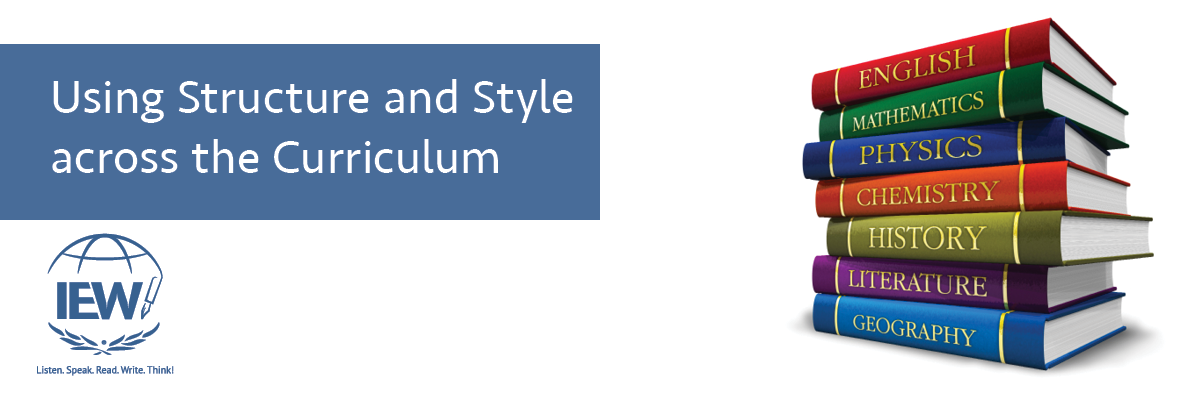
“I hear and I forget; I see and I remember; I write and I understand.” According to this Chinese proverb, writing about something leads to understanding it. While writing instruction is commonly considered an activity for the English Language Arts (ELA) classroom, the goal is that students will transfer the skills learned in ELA to writing assignments in other classes. Teachers in all disciplines can use the Structure and Style method to help students learn to write about their subject matter. Make sure all the teachers at your school have access to a Premium Membership, which includes the Teaching Writing: Structure and Style videos, and use some of the following ideas to implement writing into all classes.
Textbooks contain excellent source material for Unit 1: Note Making and Outlines and Unit 2: Writing from Notes because they are written at a reading level appropriate to the grade. Since these units are taught at the beginning of the school year, pick a paragraph in the first chapter that highlights an important concept, preferably one that students will use all year and need to understand for success in your classroom. In my sixth-grade geography class, the textbook had great paragraphs explaining longitude and latitude and the five themes of geography. Math teachers might find a paragraph explaining the order of operations while science teachers could use a paragraph about the scientific method or lab safety. In “Writing across the Curriculum” (Episode 294), Andrew Pudewa suggests finding supplemental articles with interesting and maybe even bizarre information to engage your students.
The Story Sequence Chart introduced in Unit 3: Retelling Narrative Stories works fabulously to retell nonfiction narratives about historical events such as wars, battles, and important discoveries. These events involve people (characters) and happen somewhere (setting) and include a problem, conflict, or need. Each has a point where success or failure is determined (climax), and there is a resolution and a lesson learned, which is why the event is important for students to study. When retelling nonfiction events, have students stick to the facts and limit creative retelling. Focus on asking questions to fill out the Story Sequence Chart.
Teachers can use Unit 4: Summarizing a Reference to help students understand what they are reading. Ask students to summarize a section or chapter in a textbook. In my ninth grade Survey of American Literature class, each unit of study in the textbook began with a thorough introduction. To help focus the students’ study prior to each unit, I had them write three paragraphs using topics covered in the introduction: historical context, style and themes, and important authors and works. Used in any discipline, this type of assignment orients students to the terms and concepts they will be using during that unit of study. Summarizing articles from sources outside the textbook is also valuable.
The Unit 5: Writing from Pictures structural model can be used in a variety of subjects. Music teachers can have students listen to a piece of music and describe it, and art teachers can use masterpieces from any genre or even student-generated art. In core content classes it can be used to interpret graphs. Pictures that show the precipitation cycle, stages of mitosis, or how the earth’s tilt affects seasons can help students explain the process in their own words. As in Unit 3, since these are actual processes, limit students to the facts that are in the picture. Asking questions to explain what is happening in the pictures helps students think about the process and understand it more thoroughly. During the activity teachers can help students develop word lists that are appropriate for explaining scientific and mathematical principles.
Use Unit 6: Summarizing Multiple References to write topic-based paragraphs in any class. Students may write about famous scientists, mathematicians, or historical figures or events.
Have students practice using the Unit 7: Inventive Writing structural model to answer essay questions on tests. Teach them to use the key word outline to break the essay question into topics, organize with topic and clincher sentences, and conclude by explaining what is important about the essay topic and why. Asking themselves the questions associated with the Unit 7 model, students are able to pull the information they learned out of their brains and organize it into a thorough, thoughtful answer. Since students are under a time constraint to answer a test essay question, focus more on structure than style.
For Unit 8: Formal Essay Models have students add an introduction and conclusion to their Unit 6 research reports to tell what is significant about their scientist, mathematician, or historical figure or event. Upper high school students can use this model for capstone projects or final thesis papers, persuasive or argumentative essays and speeches, or even debates. The webinar Unit 8: Easy Essays and Beyond offers great insight for this unit.*
Using the Response to Literature analysis topics presented in the Unit 9: Formal Critique model, fine arts students can critique music or art pieces. Core content classes can use this model to analyze documentaries, speeches, advertising, and news articles. Refer to page 163 in the Teaching Writing: Structure and Style Seminar Workbook to find a list of analysis topics. The webinar Unit 9: Formal Critiques: Going beyond the Boring Book Report offers great insight for this unit.*
With these ideas you can create purposeful and engaging assignments for your students to develop their writing skills. The key to student success is providing source material at the appropriate reading level, modeling the structure and style, and providing examples for the students to follow. Be sure your checklist aligns with the ELA class’s checklist. Students’ confidence and ability will increase with each additional opportunity to use the Structure and Style method. Most importantly, they will be armed with writing strategies to demonstrate their understanding of any topic.
by Andrea Pewthers
*These two webinars refer to High School Essay Intensive, which is a discontinued product. IEW now recommends University-Ready Writing.
